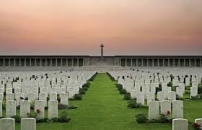| First Name: | William | Last Name: | HEALEY | |
|---|---|---|---|---|
| Date of Death: | 01/04/1918 | Lived/Born In: | East Sheen | |
| Rank: | Rifleman | Unit: | Rifle Brigade11 | |
| Memorial Site: | Pozieres Memorial, France | |||
Current Information:Born-Wandsworth
With an end to the fighting on the Eastern Front after the Russian Revolution, Germany was able to bring its troops from there to France and launch a series of offensives in the Spring of 1918, designed to bring the war to a swift conclusion. Four times between March and July they attacked in strength and on each occasion they broke through the British and French lines and made spectacular gains but in each case they over extended themselves and without adequate supplies keeping up with their rapid advances, they could go no further. The first of these attacks, Operation Michael, was made on 21st March by 63 specially trained divisions, attacking along a 60 mile front held by 26 British divisions, many of them in a weakened state At 4.40am the German artillery opened up with the most ferocious and concentrated bombardment of the war, the likes of which the British had never experienced before. The Forward Zone, consisting mainly of individual posts was blown away. Very few of the men there made it back. Many were killed and many more were taken prisoner. The Battle Zone was also battered as were the British guns, firing from positions just to the rear. Brigade and Divisional HQs were targeted as well and then, from out of the thick mist came the German storm troopers. Moving fast, they skirted round the few remaining strongholds and penetrated deep into the British lines, including those of the Battle Zone, causing the utmost confusion. There were many cases of heroic stands being made but the relentless pressure forced the British back everywhere and there then began a general retreat that went on for two weeks and which ceded to the Germans a huge amount of territory, including all of that that had been won at such great cost during the Battle of the Somme in 1916. 20th Division were not in the front line when the Germans attacked on 21st March. They had moved south from Ypres to the southern part of the Somme front near St Quentin in February and were in XVIII Corps reserve that day with orders to move forward to man the rear zone defences between the Somme and the Omignon from St Simon to Trefcon. On 20th March the 11th Rifle Brigade battalion of 59 Brigade marched from billets in Candor to Ognolles and on the following day, when the Germans launched their attack, they moved forward to the Villers-St Christophe area and that night manned the defences at Germaine and Lanchy. By now the British Fifth Army was in retreat along a broad front and for the next week, 11th Rifle Brigade fell back on a daily basis. On the evening of 23rd March they withdrew to a line east of Matigny where they crossed the River Somme and the canal by the bridges at Bethencourt. Here they were subjected to a sustained German artillery bombardment but managed to hold up parties of the enemy trying to cross the canal. 24th March was a day of heavy fighting. When the early morning mist cleared they discovered German troops behind them. C Company counter attacked towards Bethencourt but were outnumbered and most failed to return. With their left flank exposed and heavily shelled by both their own and the German artillery, 11th Rifle Brigade withdrew 1000 yards. Later that morning, the company in the line in front of Rouy-le-Grand were ordered by the Brigade to retake the canal positions just vacated. They advanced 700 yards but were wiped out by machine-gun and artillery fire. That afternoon 59 Brigade took up a line Quiquery to Mesnil-St. Nicaise with a scratch collection of units including the survivors of 11th Rifle Brigade. On 25 March, just before dawn, 11th Rifle Brigade and accompanying units were shelled and attacked as the Germans moved down the Mesnil-St, Nicaise to Nesle road. They withdrew to south of Nesle and that evening moved further back to Roye The next morning what was left of the battalion marched from Roye to Quesnel where defensive positions were taken up On 27th March they were involved in a counter attack which helped slow down the German advance but not stop it and on the following day they withdrew to a wood on the Amiens-Roye road, south of Démuin. 29th March saw them involved in a fierce struggle around Mézières-en-Santerre and that night they moved to a position along the Moreuil-Démuin road. The retreat continued on 31st March when the enemy artillery forced a withdrawal back across the Luce to a position between Domart and Hangard. On the night of 1st April 20th Division was withdrawn from the line and from the battle and the next day 11th Rifle Brigade moved to Selincourt for a well earned rest. Their casualties during this period amounted to 440, killed, wounded or missing. In the confusion of battle and retreat it was nigh on impossible to keep up with all these losses and it was only on 1st April, a day when there were no casualties in the battalion, that many of the deaths, including that of William Healey, were officially recorded, whereas the actual date of their deaths would have been some time between 22nd and 31st March. |
||||
| « Back to Search Results | ||||
| If you think any of the information shown here is incorrect, Click Here to submit your amends and comments | ||||




